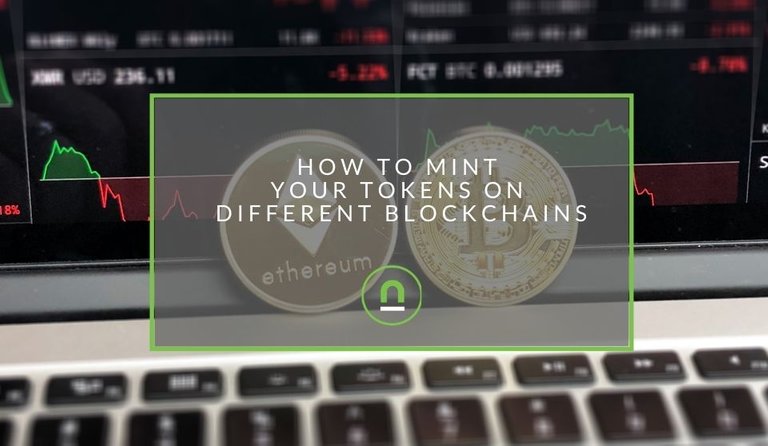How To Mint Your Tokens On Different Blockchains
Cryptocurrency is still very much an unknown quantity, even with it's oldest iteration Bitcoin, soldiering along for over a decade, the technology is still unexplored territory. As blockchain the underlying technology cryptocurrencies expand, corporates and startups are looking to make a play in this sector.
The world of cryptocurrency created a new brand of internet users and applications all centred around tokenomics. Tokens are being issued on various blockchains each day all with their different purposes; it could be a representation of equity in a project, it could be a utility token to purchase or access services on a dApp or a range of dApps. It could be a way to structure governance or a way to raise funds for a project.
Tokenisation is still very much in its infancy, and experimentation is rife in the space. One can easily be swept up by the promise of different tokens and chains, and it can all get a bit confusing how it all works.

One token, one chain
When creating a token for your project, you'll need to select a base chain that you feel most comfortable using. Blockchains may be secure and decentralised and offer other features depending on each chain, but they are also very limiting when compared to a centralised database. There are trade-offs with each chain, and you should consult a blockchain professional to advise you on the best chain for your project. Once you select a chain, to launch your token, you're stuck with that chain going forward.
You can, however, take a snapshot and migrate your data and accounts to another chain or sync it in future but this can cause more issues than they are worth, which is why it's essential to pick a base chain that you can scale with over time.
Popular token creation chains
There are several chains with smart contract functionality that you can use to create your project token. Ethereum is one of the first smart contract blockchains has solidified itself as the most popular token platform to date, and for a good reason.
It's ERC-20 token, and token standard variants offer most projects all they need to get started. It's also one of the most decentralised of the smart contract platforms and provides a measure of security that is attractive to token holders.
The Ethereum ERC-20 protocol is also widely accepted by the majority of decentralised and centralised exchanges, making it easier for projects to list on exchanges and access new investors.
Several other blockchains offer tokenisation, namely:
- TELOS
- NEO
- EOS
- TRON
- TEZOS
- COSMOS
- BNB
- STEEM/HIVE*
Note: HIVE and STEEM offer tokenisation via a side chain known as STEEM/HIVE Engine which uses smart contracts and secures the transaction data on the mainchain via custom JSON. The launch of main chain native tokens known as SMT remains in development.
Chain interoperability
Blockchains are merely distributed databases, and smart contracts are limited to the environment they are built-in, which means data such as tokens on one chain, cannot interact with tokens or dapps, or exchanges built on another chain.
The blockchain community realises chains cannot live in a silo, and interoperability is key to unlocking the true power of various chains. There have been implementations of atomic swaps between certain chains with Bitcoin, ETH, TEZOS and ZCash atomic swaps looking likely to be some of the first.
However, as each chain as its unique codebase, it adds an additional layer of complexity in moving tokens and data across chains. In the case of tokens, most users who want to switch chains do so via centralised exchanges trading one token for another, but this can be costly and inefficient as well as involving KYC and other personal information.
What are representative tokens?
To bridge the gap between blockchains, the concept of representative tokens have come into play. One of the very first iterations was the liquid network which is a side chain based on Bitcoin, which allows users to lock up BTC with a federation (custodial service) and they receive a token that represents their BTC, known as LBTC (Liquid Bitcoin).
A user can then trade and use their LBTC on various on-chain dapps, and when they want to exit they can trade their LBTC back for the promise of their BTC or the value of LBTC that remains.
As of 2020, Ethereum DE-FI has taken off, and as users were looking to provide value to trade on the chain, they found trading through centralised exchanges to be a roadblock. To avoid exchanges and overcome these inefficiencies, smart contracts have been developed on Ethereum which allow you to lock up another token and receive a representative version of the token hosted on Ethereum.
For example, instead of trading Bitcoin for Ethereum, a user can send Bitcoin to a smart contract and receive an ETH equivalent token known as wBTC or wrapped BTC. This wBTC will function like an ERC-20 token but maintain the value of the asset pegged to it.
How to mint or wrap a token
Atomic swaps from any chain is still a while off, and this bridge to chain interoperability may be limited, but it is a step in the right direction. If you already own tokens or working on a project and you'd like to access other dapps, tools and markets that aren't native to your chain, then wrapping your token is a great idea.
To use a non-native token on another blockchain, you first need to find out if they support pegging or wrapping assets on-chain. If the chain you want to use offers smart contract asset wrapping, then you can create one and provide liquidity to allow users to flow in and out of the various chains.
If you're interested in pegging your token on another chain, the following options are now available.
Wrapping on Ethereum
Ethereum is the pioneer of wrapped tokens with wBTC and wETH dominating the wrapped market of late as many traders are using these tokens on various DE-FI platforms and exchanges. To wrap your token in ETH you need to create a smart contract on the Ethereum network that will act as the bridge and custodian of the pegged asset. Once your smart contract is live you will be able to issue wrapped version of your token on Ethereum.
Wrapping on Tron
tBridge is built on the Tron blockchain and enables the trust-less and decentralised exchange of value between blockchains - bringing interoperability to TRON based dapps and DeFi. tBridge can provide a native cross-chain user experience allowing seamless and decentralised interoperability for the first time ever.
At the moment tBridge looks to only provide an onramp for ERC-20 tokens, so if your token is on another chain, you will first need to wrap it as an ERC-20 and then use that wrapped token to add it onto TRON via tBridge.
Pegging on EOS
pTokens or pegged tokens is EOS's answer to wrapped assets and allows you to deposit your collateral into a smart contract on EOS and mint a token that runs on their chain and native wallets.
At the moment pTokens looks to only provide an onramp for ERC-20 tokens, so if your token is on another chain, you will first need to wrap it as an ERC-20 and then use that wrapped token to add it onto EOS via pTokens.
Pegging on HIVE/STEEM
HIVE and STEEM Engine is a smart contract sidechain platform and exchange that allows you to create custom tokens. You will need to purchase 100 BEE or ENG the native token of the platform and burn it to create a token representation and then reach out to the team to have it pegged and provide additional liquidity so users can trade in and out of the system.
Peg on Binance chain
The popular centralised exchange Binance has its own DEX as well as its own chain, with a native token known as the BNB token. Binance chain allows you to port tokens to the Binance chain using their smart contract protocal known as BEP3 peg.
And that's a wrap
There you have it a guide to minting your tokens on chains that aren't native to your asset; we hope it helps you take better ownership of your project, leverage new dApps and opportunities and reach out to new communities with your token.
This is only the beginning, and as the use case has been proven with Ethereum, other chains are sure to follow, which will open up new opportunities in the crypto space especially in the decentralised trading sector.
One peg at a time
Have you wrapped a token before? Which token and chain did you use? Do you know of any other token minting protocols? Let us know in the comments below.
- Source: nichemarket
Have your say
What do you good people of HIVE think?
So have at it my Jessies! If you don't have something to comment, comment "I am a Jessie."
Let's connect
If you liked this post, sprinkle it with an upvote or esteem and if you don't already, consider following me @chekohler and subscribe to my fanbase
| Browse & Earn Crypto | Stack Sats For Free | Earn Interest On Crypto |
|---|---|---|
 |  |  |
Posted Using LeoFinance Beta

Hey man, quality long form post.
Straight away I thought this was awesome original content for the leofinance.io domain, but Google has the nichemarket.co.za version ranking and we're just a duplicate.
Sigh.
Posted Using LeoFinance
Thanks, man, lol sorry the posts I do a lot of research on I will always post on my website first since I can get consistent revenue from them whereas on LEO its once-off.
I do post some exclusive content but I tend to mix it up. I also syndicate my content on medium and its all about reaching as many readers as possible for me
Posted Using LeoFinance Beta